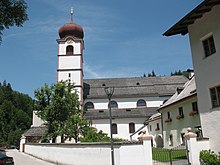Mariathal pilgrimage church
The parish and pilgrimage church of Mariathal in the village of Mariathal at the entrance to the Brandenberger Valley is a Roman Catholic parish church in the municipality of Kramsach in the Kufstein district in Tyrol . The church consecrated to St. Dominic belongs to the Archdiocese of Salzburg . The church was founded in 2008 by Pope Benedict XVI. raised to the minor basilica .
Founding legend
The founding legend tells that a knight Berthold von Fruntsprung wanted to go hunting with his brother, drew his bow and aimed at the shutters of his brother's bedroom window to wake him up. At the same moment he opened his window, was fatally struck by the arrow and fell down. Berthold wandered around in the woods of the Brandenberger valley and found the picture of the painful Mother of God in a tree at the exit of the valley . At this point he had a monastery built. The image of Mary is still venerated today and is located in the Chapel of Grace.
history
The brothers Friedrich and Chunrad von Freundsberg founded the church with a monastery in 1267, dedicated as a burial place to their family. With the loss of power of the family, the church and monastery also lost their reputation. The monastery came into the possession of the Dominican Sisters in the middle of the 15th century . After a fire, the church was rebuilt from 1680 to 1682 using the late Gothic masonry in the Baroque style. In the interior, the colors gold and black dominate, a requirement of the Dominican women. Pope Innocent XI. (1676–1689) donated the relics of St. Privata, a catacomb saint , to the church . This led to an upswing as a place of pilgrimage.
The monastery was abolished in 1782 by Emperor Joseph II , the church was taken over by the parish church of St. Petrus was taken over as chaplain in Breitenbach am Inn . In 1863 nuns returned to the monastery walls, this time the Sisters of Mercy of St. Vincent de Paul . Four years later they opened an elementary school for orphaned girls. The church was elevated to a parish church in 1891. The Nazi authorities closed the elementary school in 1938 and ordered in 1939 that the sisters had to take in and care for severely mentally handicapped children and adults. In 1941 the fosterlings were transported away and murdered as part of Operation T4 . The monastery was confiscated and used as the Gau's own home for girls. After the fall of the Nazi regime and the return of the monastery to the order, the state of Tyrol bought the home in 1950 and continued to run it until 1971. Since then, the former monastery has been functioning as the Mariatal special school with boarding school.
architecture
The church is a three-aisled hall church . The sacristy , a Lady Chapel and a vestibule are built on the south . The six-storey church tower is positioned on the southwest side and covered with an onion dome. Four large arcade windows open in the bell chamber on the upper floor . The lower part of the tower is late Gothic, the year 1488 is entered above the basement. The south portal is set in an aedicule and covered with a segmented gable with the year 1682. The wooden door has a cartilage carving . A Madonna figure stands in a round arch niche above the south portal.
The three-bay nave with a round arched triumphal arch and a drawn -in two-bay choir with a 3/8 end is vaulted with groin vaults between belt arches .
The nave is structured by strong wall pillars and a circumferential cranked beam . Above are arched walls with arched windows. The two-axis two-bay west gallery was used as a nuns choir and shows the inscription Prioress Katharina Haun 1519. The northern portal in the choir with a marble garment with pilaster framing is signed and dated FP 1622. Both the two-bay Marie chapel with a Vorjoch and the three-pile sacristy with lunette tons vaulted, with Laubbandlwerkstuck equipped and dated 1739th The original stucco in the nave was destroyed in a fire in 1880. These furnishings were replaced in 1956 by Hans Ladner and Anton Gogl with figural stucco.
organ
The organ was installed in 1736 by the Salzburg organ builder Johann Christoph Egedacher , allegedly as a dowry of a daughter who entered the Dominican Sisters. The case and some pipes have been preserved. In 1861, Matthäus Mauracher largely converted the work to a pneumatic action. In 1972 the organ received a new work with Orgelbau Pirchner .
literature
- Dehio Tirol 1980 , Kramsach, parish and former Dominican church hl. Dominikus, in Maria-Thal, pp. 435-436.
Web links
Individual evidence
- ^ Mariatal, Sonderschule mit Internat: Historisches , accessed on December 16, 2019
- ^ Organ in the parish church of Mariathal, Kramsach kirchen.net, undated
Coordinates: 47 ° 27 '16.3 " N , 11 ° 51' 55.6" E

